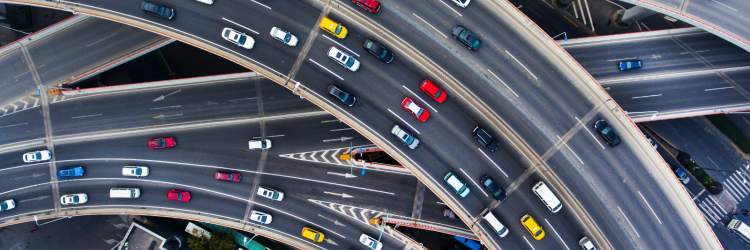The surge in traffic fatalities in the U.S. in recent years was initially blamed on distracted driving and then on habits that drivers adopted when the pandemic cleared so many cars off the road, tempting people to go recklessly fast -- but other countries face the same issues and haven't seen nearly the same problems as the U.S. has.
While the U.S. and France, for instance, had roughly the same rate of traffic fatalities per capita in the 1990s, an American is now three times as likely as a Frenchman to die in a traffic crash.
What's going on?
A recent New York Times article argues that, basically, Americans are thinking about the problem wrong. First, we Americans don't think about the full system. We think about the cars, first and foremost, and about the drivers a considerable extent but don't focus nearly enough on the third component of the system: the roads. Second, we focus on the safety of the people inside the cars but spare too little thought for the people outside the cars: the pedestrians, cyclists and motorcyclists, who are being killed in far greater numbers than in the past.
The article says:
“'We are not the only country with alcohol,' said Beth Osborne, director of the advocacy group Transportation for America. 'We’re not the only country with smartphones and distraction. We were not the only country impacted by the worldwide pandemic.' Rather, she said, other countries have designed transportation systems where human emotion and error are less likely to produce deadly results on roadways."
In particular, the article says, "Other developed countries lowered speed limits and built more protected bike lanes. They moved faster in making standard in-vehicle technology like automatic braking systems that detect pedestrians, and vehicle hoods that are less deadly to them. They designed roundabouts that reduce the danger at intersections, where fatalities disproportionately occur." The U.S., by contrast, has "a transportation system primarily designed to move cars quickly, not to move people safely."
The National Highway Traffic Safety Administration, a division of the Department of Transportation, estimates that nearly 43,000 people died in motor vehicle traffic crashes in the U.S. in 2021, up 11% from 2020 and 18% from 2019. That is the biggest two-year increase since 1946 and follows a decades-long, steady decline in fatalities that lasted until the mid-2010s.
The NHTSA estimates that motor vehicles killed more than 7,300 pedestrians in 2021, up 13% from 2020.
The problem may even get worse. Americans continue to buy cars that are heavier and higher off the ground, which are more likely to kill any pedestrian, cyclist or motorcyclist they hit and to crunch small sedans. The switch to electric vehicles will exacerbate the problem because their massive batteries make the vehicles much heavier than their counterparts using internal combustion engines. EVs also accelerate much faster than ICEs do.
Just think of the Hummer EV, which weighs more than 9,000 pounds and can go from 0 to 60mph in roughly three seconds.
Safety technology in cars is improving rapidly and will continue to do so as sensors and software developed for autonomous cars are more widely deployed. Technology can also make drivers safer, especially as smartphones provide data about driving behavior and as insurers offer incentives for those who avoid sudden acceleration, hard braking and other often-dangerous actions.
But experts say we need to go beyond improving cars and drivers and focus on the roads and on vulnerable users, such as pedestrians, who aren't wrapped in thousands of pounds of protective metal.
The infrastructure bill that Congress passed last year will help. It provides funds for pedestrian and cycling infrastructure and requires that states where vulnerable road users make up at least 15% of fatalities must spend at least 15% of their federal safety funds on improvements prioritizing those vulnerable users. Today, 32 states, Puerto Rico and the District of Columbia face that mandate.
Experts say cities and states should also rethink road design -- for instance, having roads narrow in areas where there is significant pedestrian or bicycle traffic, to make drivers a bit uncomfortable and signal to them that they need to slow down.
Consumer Reports says "dozens of cities in the U.S. are completely rethinking road design with safety top of mind."
In 2014, New York adopted the Vision Zero concept, which uses big-data analysis to identify and improve dangerous streets and intersections and calls for city planners to rethink everything about roads, bike lanes and pedestrian routes, in the hopes of eliminating all vehicle-related deaths. In Seattle, officials reduced the number of traffic lanes on Rainier Avenue and subsequently reported no serious injuries or deaths on that dangerous stretch. New York City transformed Queens Boulevard into a more pedestrian-friendly road with protected bike lanes and trees and went from seeing more than seven pedestrians killed or severely injured per mile on the road to no fatalities in the two years after the redesign began in 2015.
The surge in traffic deaths in the U.S. won't be reversed easily. Too many factors are working against us. But the analysis in the Times seems smart to me: We can do a lot of good by redesigning roads and by focusing on those who aren't in cars, as well as those who are.
Government is taking a lead role, as it should, with efforts such as those in the infrastructure bill, but the insurance industry can play a key role, too. It can marshal its enormous amounts of data on accidents and advance smart arguments at every opportunity about how to increase safety. It can also expand on the work it's already doing to offer incentives that will encourage safer behavior.
As the industry moves toward a "predict and prevent" model and away from the traditional "repair and replace," auto safety is an area where the insurance industry can, and should, shine.
Cheers,
Paul


